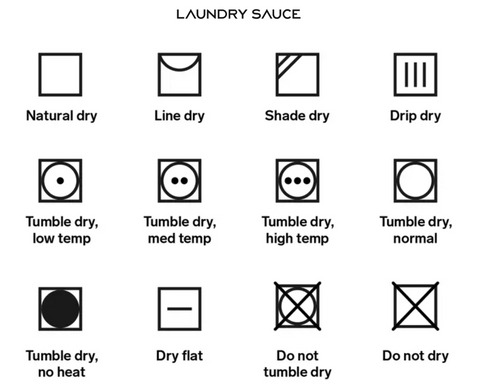Mastering the art of perfect drying techniques is not just about choosing the right settings but also about understanding your fabrics’ needs. Whether you’re aiming to protect delicate garments or ensure your favorite jeans come out just right, knowing how to navigate the world of tumble drying is essential. For more tips and advice on garment care, visit inktasticmerch.com and explore our range of products designed to keep your wardrobe looking its best.
Tumble drying is a method of machine-drying clothing rather than allowing them to air-dry. You can utilize various heat settings—low, medium, high, or none—depending on the fabric type.
Understanding how to wash and dry your clothes according to their specific care instructions is critical. It not only helps avoid issues like shrinkage and damage but also prevents color bleeding. However, interpreting those laundry symbols and care labels can often feel like learning a new language.
Among the many terms you will encounter, “tumble dry” frequently pops up. But if you scan your dryer settings and don’t see that exact phrase, it can lead to confusion. No one wants their favorite shirt to come out of the dryer looking two sizes smaller. To help, we’ve created a guide detailing what “tumble dry” means, how to use this setting effectively, and tips to determine if your clothes are tumble-dry safe.
Defining Tumble Dry
Simply put, tumble dry refers to the process of drying clothes in a machine dryer. The name arises from the tumbling action that takes place inside the dryer drum, which uses heat and airflow to eliminate moisture from your garments.
This method of drying is faster and often more convenient than hanging clothes on a drying rack, although air-drying is excellent for maximizing your laundry detergent’s scent and maintaining your fabric’s integrity.
Before you jump into using your dryer, it’s crucial to know if your clothes can withstand tumble drying and which heat settings are appropriate.
Understanding Tumble Dry Settings: High, Low, and No Heat
Your dryer typically features four main tumble dry settings:
1. No Heat (Air Only)
This setting rotates your laundry without applying any heat at all, circulating room-temperature air instead. It’s a gentler option, ideal for delicate fabrics or sensitive garments, as it helps avoid shrinkage, damage, or wrinkles that can occur with heat.
Consider using the no-heat setting for:
- Delicate fabrics like silk or wool
- Fluffy blankets, pillows, and winter coats
- Refreshing items that have collected pet hair, dust, or debris
2. Tumble Dry Low (Delicates)
The tumble dry low setting typically operates at around 125 degrees Fahrenheit, making it perfect for delicate items or activewear composed of sweat-wicking materials like spandex or lycra.
Use a low-heat setting for:
- Synthetic fabrics such as polyester, nylon, spandex, and acrylic
- Fabrics like silk, satin, lace, chiffon, and velvet
- Down coats and lingerie
- Knit sweaters
3. Tumble Dry Medium
The medium heat setting, often referred to as “normal,” heats the air to about 135 degrees Fahrenheit. This choice is suitable for fabrics prone to wrinkling, such as polyester and nylon, as well as cotton items, though caution is advised since cotton can shrink.
Opt for a medium-heat setting for:
- Trousers and slacks
- Button-up work shirts
- Thin cotton items, including t-shirts
4. Tumble Dry High Heat
This is the highest temperature setting, reaching up to 150 degrees Fahrenheit. It’s reserved for heavy-duty items that take longer to dry. Avoid using this setting for delicate garments, as it can lead to significant damage.
Best for high-heat drying:
- Beach towels and bath towels
- Jeans
- Heavy work clothes
- Sweatshirts and hoodies
- Bedsheets
Determining If a Garment Can Be Tumble Dried
To see if a piece of clothing can be tumble dried, look for a square symbol with a large circle inside it on the care label. If there’s an “X” through this symbol, it indicates that the item should not be placed in the dryer.
For specific drying instructions, always check the care label—it will inform you whether tumble drying is safe and what heat settings are recommended.
Here’s a handy reference for dryer symbols:

Understanding “Do Not Tumble Dry”
If the care label reads “do not tumble dry,” it indicates that the garment should never be put in the dryer. Instead, adhere to the manufacturer’s drying instructions. If no information is provided, it’s safest to air-dry the item, which can help maintain its shape and fabric integrity.
Failure to heed this advice not only risks shrinkage and color fading but can also lead to pilling over time. Additionally, tumble drying items with elastic components can diminish their stretch. In short, ignoring this care label could be detrimental to your garment.
Three Tips for Effective Tumble Drying
Now that you’re well-versed in tumble drying, here are a few additional tips to help you dry your clothes like a pro:
1. Sort Your Laundry Before Drying
While it might be tempting to toss all your wet laundry into the dryer indiscriminately, sorting is essential to protect your fabrics.
- Dry white items separately from dark-colored clothing to avoid color bleeding
- Keep towels and sheets together to prevent lint transfer
- Separate items based on their heat tolerance
2. Use Wool Dryer Balls for Faster Drying
Although tumble drying is convenient, it can sometimes take longer than desired, causing clothes to tangle. Wool dryer balls can make a difference by enhancing airflow between garments, preventing clumping, and speeding up the drying process.
Wool dryer balls made from 100% New Zealand wool can last up to 1,000 loads.
3. Incorporate Dryer Sheets to Minimize Static Cling
The combination of heat and agitation in the dryer is a breeding ground for static electricity. To combat this common issue, a couple of dryer sheets can help by depositing fabric conditioners during the drying cycle.
High-quality dryer sheets not only combat static cling but also infuse your laundry with delightful fragrances, elevating your laundry experience.
For more insightful tips and advice on taking care of your garments, explore our Blog where you’ll find a wealth of information to enhance your laundry routine.



